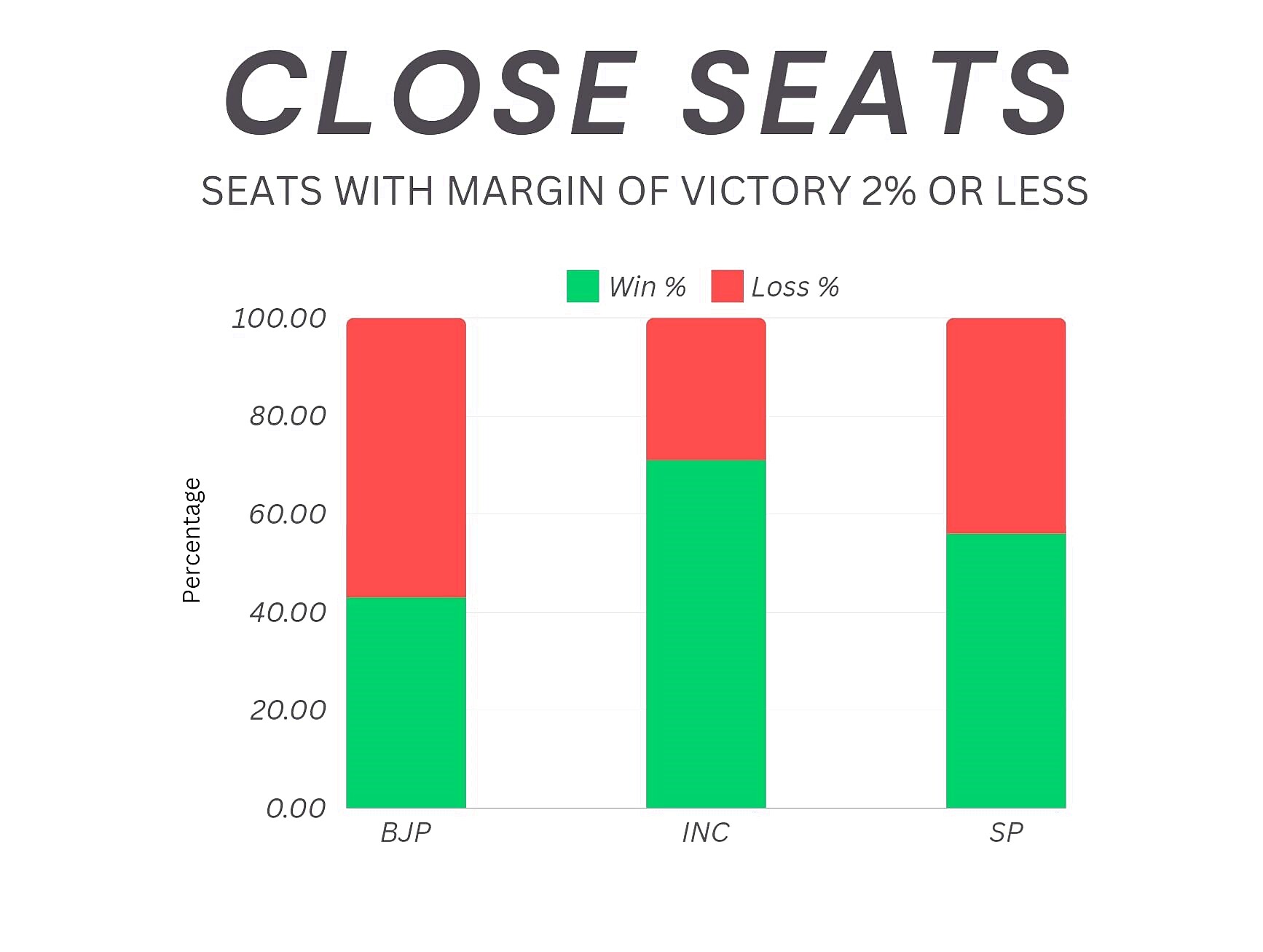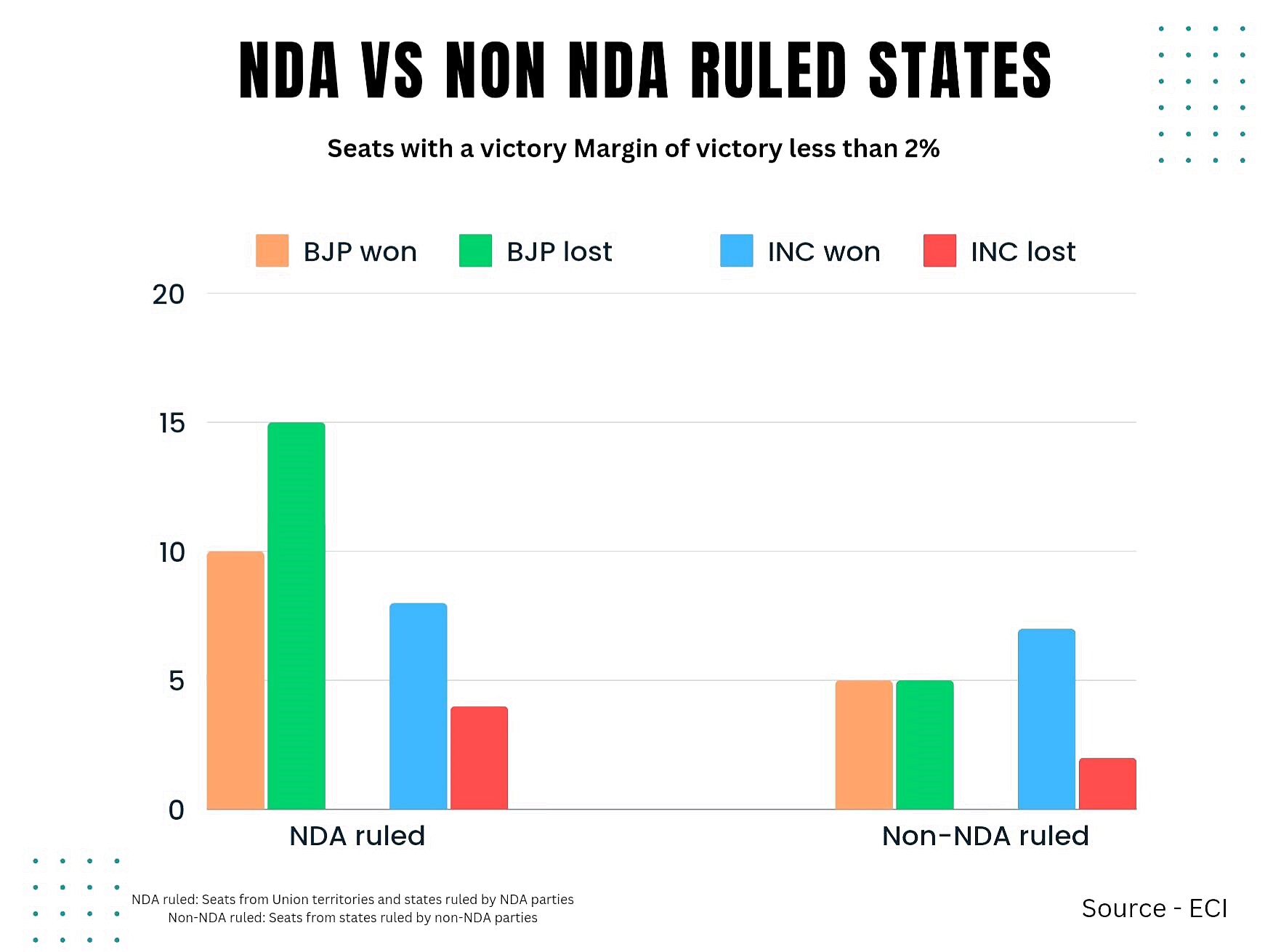
views
June 4, 2024, took everyone by surprise, from pollsters to markets to chai-shop Chanakyas, and maybe even Professor Sabyasachi Das. Remember his accusations? Last year, Professor Das of Ashoka University published a paper on the 2019 general elections, highlighting how the BJP won most of the close seats they contested, especially in NDA-ruled states, and insinuated that it was due to electoral manipulation. Well, those allegations amounted to nothing, as this time, the BJP drew the short end of the stick.
INC: Fortunate, BJP: Unfortunate

In 2019, BJP’s strike rate on close seats (seats with a victory margin of < 2 per cent) was 74 per cent, a remarkably high number that raised a few eyebrows. Was this suspicion justified? If you compare the BJP’s strike rate on close seats to its overall strike rate of 69 per cent in the 2019 elections, there seems to have been no cause for alarm. The BJP was almost as likely to win a close seat as it was to win the average seat.
This trend did not hold in the 2024 elections. BJP’s strike rate on close seats fell drastically to 43 per cent. It lost 20 out of the 35 such seats where it was in contention. Indian National Congress (INC), on the other hand, was a contender in 21 such seats and won 15 of those with an impressive strike rate of 71 per cent. Even the largest ally of the Congress, the Samajwadi Party, saw success, winning 6 out of the 10 close seats where it was in contention.
Contrary to the 2019 elections, the BJP’s 43 per cent strike rate in close contests this time around was significantly less than their overall strike rate of 54 per cent. In contrast, the INC’s 71 per cent strike rate on such seats was more than double their overall strike rate of 31 per cent. Had those strike rates on close seats been swapped, the BJP would have added 10 more seats to their national tally and the INC would have lost 6 from the 99 they won. It seems, more than electoral manipulation, the last two elections for the BJP are a classic case of “you win some, you lose some”.
BJP fared worse in NDA ruled states

Professor Das’ paper highlighted the BJP’s over-performance in close seats in NDA-ruled states during the previous election. However, this trend did not continue in the 2024 elections. In NDA-ruled states or Union Territories, the BJP lost nearly 60 per cent of close seats, while the INC won nearly 67 per cent. In non-NDA ruled states, the BJP won as many as they lost, whereas the INC won a remarkable 78 per cent of all the closely contested seats in which they were contenders.
While I will not accuse them of electoral manipulation, a natural question arises: If the BJP rigged the elections in NDA-ruled states to win most of the closely contested seats in 2019, why didn’t they do the same in 2024 when they were targeting 400 seats?
INDIA’s Top 2 Are Vulnerable
If you ask an average Indian who they think will win the 2029 elections, chances are most would say INDIA. Yet, if the Congress and Samajwadi Party analysed the margins of victory and defeat in the 2024 elections, they would realise that they are vulnerable, and while the BJP may be weakened, it is far from being defeated.
The INC lost 219 out of the 318 seats they contested in. Only 11 of these defeats came with a margin of less than 30,000. In other words, nearly 95 per cent of the INC’s defeats weren’t even close. If you compare this to the BJP, almost 15 per cent of their defeats were by less than 30,000 votes.
If we consider more than 1 lakh votes to be a safe margin, the BJP won 150 seats – representing 62 per cent of their total seats – with a safe margin. Of these, 95 wins were by a margin of over 2 lakh votes, which is 4 less than the INC’s overall tally. In contrast, only 46 of the INC’s 99 victories were won with a safe margin.
Akhilesh Yadav emerged as the hero of the 2024 election, as the Samajwadi Party won more seats than the BJP in Uttar Pradesh, a state that was beginning to look like a BJP bastion. Their victory, especially in Ayodhya, would have tasted sweet. But the devil’s in the details, and if they’d looked closely enough, they’d have found a few.
Only 35 per cent (13) of their seats were won by a safe margin by the SP. Only 2 victories came with a margin of more than 2 lakh votes. In fact, almost one-third of all SP’s victories came with a margin of less than 50,000 votes. This is significant in a state like Uttar Pradesh with a large population and essentially a bipolar contest on most seats.
The Congress and its largest ally in the Lok Sabha are on shaky ground even in their moment of joy, with many of their seats being vulnerable, while the BJP, amid its decline, remains dominant and statistically has a better chance of turning things around.
Another group that is on shaky ground after June 4 is the conspiracy theorists. However, I am more confident in their ability to turn things around than I am in the BJP’s. The BJP would need a strong campaign, a solid track record, the benefits of incumbency, and a significant number of votes. All conspiracy theorists need is a BJP victory in a state election (or perhaps not even that) to start alleging EVM hacking or mass-scale election rigging once again.
Nitish Singh focuses on providing data-driven commentary on Indian politics. Views expressed in the above piece are personal and solely that of the author. They do not necessarily reflect News18’s views.




















Comments
0 comment